It’s a great feeling to welcome wild birds in to your garden. Natural habitats are dwindling in many areas, so it’s also rewarding to know that you’re helping wild birds find something nutritious to eat, especially through the cold winter months. In this post, we’re looking at a DIY easy bird feeder you can make for next-to-nothing in just a few minutes.
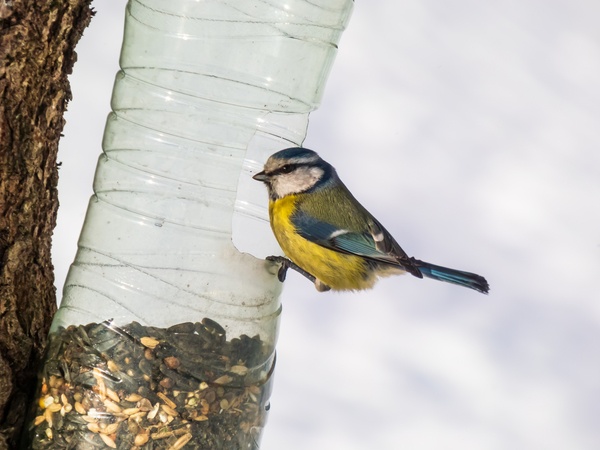
Don’t Buy, DIY
While you might find bird feeders for sale in garden centres, larger supermarkets and home / DIY stores, there’s really no reason why you can’t make your own very easily from recycled materials at home. This saves you money and also helps the environment – especially as many bird feeders on the market are made from plastic.
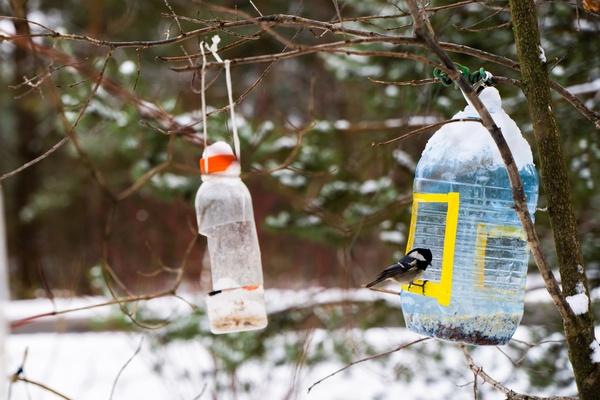
Having researched and tried out various designs, this article is based around the very simple idea of upcycling used plastic bottes into seed holders. I did also look into an alternative type of feeder, which you might call a bird ‘cake’ or cookie, but we’ll cover that in another post.
Make a DIY Easy Bird Feeder
What You’ll Need
- Used plastic bottles, ideally with lids
- A sharp object to make holes – such as a pin / needle / knife or scissors
- Something to use for a perch – pencil / wood dowel / spoons / straws / skewers / sticks
- Something to hang your feeder – wire / string / twine
- Bird seed
Method
Making bird feeders from used plastic bottles is really very simple.
- Clean out the plastic bottle and remove labels.
- Using a drawing pin / needle make some small drainage hols at the bottom to allow any water to drip away.
- Then make some small holes in the sides (towards the bottom) for the perches. You can start the holes with a drawing pin and then make them bigger as required with a knife or some scissors. You could also use a drill bit for this.
- Add perches to the feeder using pencils / wooden dowel / spoons…or anything else that looks the right size. (In this example I have used wooden kebab skewers that I had lying around in the kitchen.
- Make a small hole around 4 – 5 cm above each perch and expand each hole to a size that will allow birds to get to the seed but not so big that it spills out easily. Of course, the actual size will depend entirely on the seed that you intend to use – more advice on this later…
- Attach some string / wire / twine to the top of the bottle so that you can hang it up. If the bottle has a handle you can simply tie around this, but otherwise you may need to make a couple of small holes near the lid to feed through.
- Fill your new feeder with bird seed, replace the lid and it’s ready to hang out in the garden.
Here is one of the best videos I’ve found on YouTube, which shows how to make your recycled bottle bird feeder…
Hanging Your Feeders
The main thing to consider when hanging your bird feeders is potential predators. In urban areas, this is most likely to be things like domestic cats who can be a devastating threat for visiting birds.
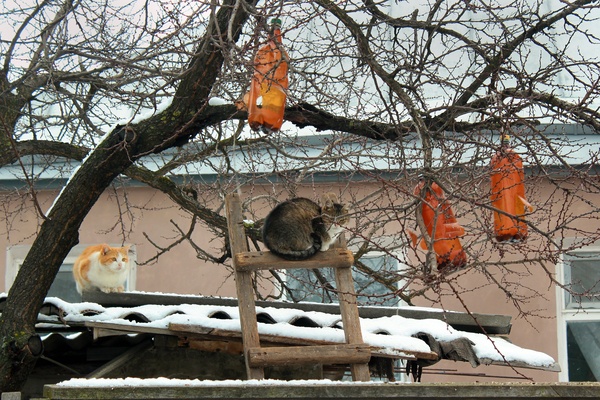
If you think about where visiting birds are most likely to feel most safe, this will most likely point to things like trees, tall posts and washing lines. If your feeders are close to some dense foliage – trees, shrubs or large pants, then this will make them safer and more attractive to visiting birds.
In general, your feeders need to be fairly high off the ground – at least eye level or above. They should also be placed away from other structures like fences or sheds, from which cats or other animals could reach them.
You might also consider the other local ‘riffraff’ who might invade your feeders – namely, squirrels or even mice and rats.
It might be possible to modify your feeder by adding a bottom tray to catch any falling seed. Birds will often drop seeds or even throw unwanted pieces and this can make a tempting snack for rodents on the ground. For this reason, I’ve tried adding plant saucer trays to my feeders by making small holes and hanging them underneath the perches.
Which Bird Seed Should You Use?
As you might expect, different types of seed will attract different birds. Of course, it’s nice to have a good mix of visitors and one of the best all-rounders would be sunflower seeds. These are enjoyed by many birds here in the UK and if you can, go for black sunflower seeds, as these are the most nutritious.
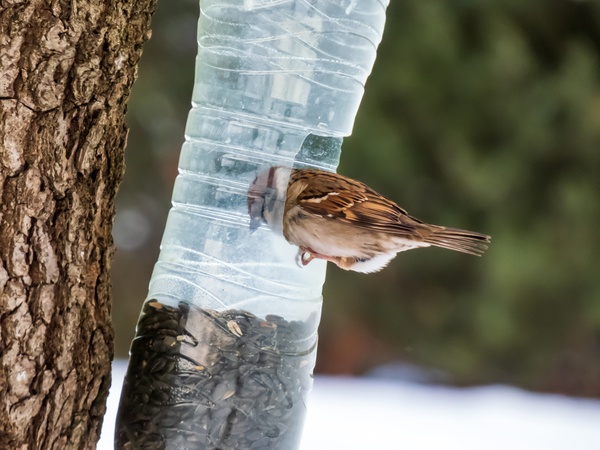
Sunflower hearts are good for attracting tits and green finches. Nyger seeds are very popular with goldfinches, although they are very small so you might need to consider this when making your feeder.
Flaked maize or millet seeds might also attract finches, along with blackbirds, sparrows and collared doves.
Peanuts – whole or crushed – can be great for birds in colder months with a high fat content. However, the Royal Society for the Protection of Birds (RSPB) advise that there are downsides to peanuts and they should only be given in winter. The RSPB also advises to avoid split peas, beans, dried rice or lentils and also to avoid mixtures with pink or green lumps – which may contain broken pieces of dog food.
As a general rule, it’s also best to buy the best quality bird seed possible and only from reputable vendors, to ensure you’re helping your garden birds and not putting them at risk.
Final Thoughts
Making your own bird feeders can be a satisfying and rewarding project and eco-friendly too. As a low cost (or even, no cost) solution, it means that you can easily try multiple feeders around your garden, using different locations and seed mixes to attract a greater variety of birds. Depending on the type of food you provide, you could attract a wide variety of feathery friends to bring added life, and perhaps even some entertainment to your outdoor space.
Which seeds have worked the best for you? Where do you hang your feeders for the best results? What kind of birds have you managed to attract to your garden? Let us know in the comments below!

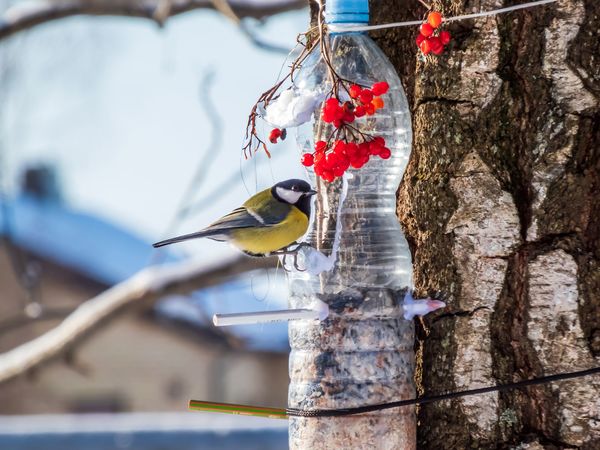
We all know how important it is to maintain contact with nature to achieve well-being and balance. One of the best ways to achieve this is to bring nature closer to our home with small and very simple gestures, such as placing a nest house or a bird feeder in our garden or balcony. So, researching about how to do it, I found your site. Thank you very much!
Thanks Ann, couldn’t agree more – keeping in touch with nature can be so rewarding, and seems the perfect antidote to modern life! Best wishes.
I had actually made something like you suggest in my countryhouse. A simple plastic box with a hole and some base so our little friends can easily land on. I don’t know why, but I find great satisfaction when I sit on my balcony and I see blackbirds, goldfinches and jackdaws coming and going all the time. It costs almost nothing but you get so much back.
Thanks Stratos, yes it’s very rewarding to be able to give them a little helping hand, especially in the colder months when food is scarce. Besides looking out for new kinds of birds, I think that even the ‘regulars’ can be quite entertaining to watch at times!
I a not really a fan of birds. In fact, I am terrified of birds. I just find them weird haha. I do however know quite a few peo who love birds and are into making bird houses so I will be sure to share this article with them. I am sure that they will find this article very useful and handy
Thanks Aubin, sounds like quite a phobia you have! Yes please do share the article and glad to hear that your friends are helping out their local wild birds. It’s fun to attract new visitors to the garden and in these times of climate change and dwindling habitats, they really do need all the help we can give them.